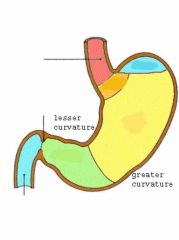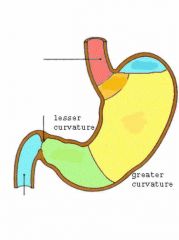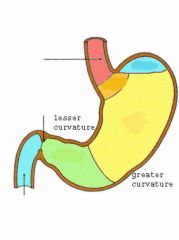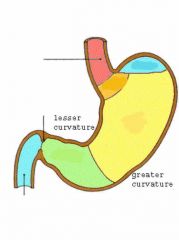![]()
![]()
![]()
Use LEFT and RIGHT arrow keys to navigate between flashcards;
Use UP and DOWN arrow keys to flip the card;
H to show hint;
A reads text to speech;
120 Cards in this Set
- Front
- Back
- 3rd side (hint)
|
What are are the 5 processes of the gastrointestinal system? |
1. Ingestion - intake of food 2. Digestion - mechanical and biochemical breakdown of large molecules into smaller, absorbable units 3. Motility - muscular contractions that mix and move contents of GI tract 4. Absorption - nutrients transferred from GI tract lumen to blood or lymph 5. Defecation - elimination of undigested/unabsorbed material |
|
|
|
Describe mechanical digestion. |
- physical breakdown of food into smaller particles - teeth and churning action of the stomach and intestines |
|
|
|
Describe chemical digestion. |
- series of hydrolysis reactions by acid and enzymes that break macromolecules into their monomers - enzymes from saliva, stomach, pancreas, and intestines - polysaccharides become monosaccharides, proteins become amino acids, and fats become fatty acids as a result of chemical digestion |
|
|
|
What are nutrients? Name all 7. |
- any life-essential substance that is digested 1. Carbohydrates 2. Proteins 3. Lipids 4. Water 5. Vitamins 6. Minerals 7. Nucleic Acids |
|
|
|
What is an essential nutrient? |
- comes from food - necessary for survival - cannot be synthesized by body |
|
|
|
What are nonessential nutrients? |
- necessary for survival - can be synthesized by body - some amino acids, some vitamins |
|
|
|
What are vitamins? |
- needed for metabolism, but not for energy - functions as catalyst or cofactor |
|
|
|
What are minerals? |
- inorganic substances (found in bones and hemoglobin) - Ca, Cl, Mg, PO3, K, Na, and Fe |
|
|
|
What are the 3 general size categories of carbohydrates? |
- monosaccharides - disaccharides - polysaccharides |
|
|
|
What are monosaccharides and what are the three main kinds? |
- simplest form of monosaccharide, monomer 1. Glucose 2. Galactose 3. Fructose |
|
|
|
What are disaccharides and what are the three main kinds? |
- made of two monosaccharides 1. Sucrose - table sugar 2. Lactose - sugar in milk 3. Maltose - sugar in beer, distilled liquids |
|
|
|
What are polysaccharides and what are three kinds? |
- 10 or more monosaccharides linked 1. Starch - form plants use to store carbohydrates 2. Glycogen - form animals use to store carbohydrates 3. Fiber (cellulose) - not digestible |
|
|
|
What are the 3 general size categories of proteins? |
1. Peptides 2. Polypeptides 3. Proteins |
|
|
|
What are the 3 general size categories of lipids? |
- yield most energy per gram 1. Fats - most common (triglycerides), fatty acids attached to glycerol 2. Phospholipids - make cell membranes 3. Steroids - cholesterol |
|
|
|
What neural controls regulate the digestive tract? |
1. Short myenteric reflexes - local reflexes like swallowing 2. Long vagovagal reflexes - parasympathetic stimulation of digestive motility and secretion |
|
|
|
What chemical controls regulate the digestive tract? |
1. Hormones 2. Paracrine secretions |
|
|
|
What are the layers of the GI tract from lumen to blood stream? |
1. Mucosa 2. Submucosa 3. Muscularis externa 4. Serosa |
|
|
|
Describe the mucosa. |
- The innermost layer of the G.I. tract wall, touching lumen/food/chyme - usually folded to increase the surface area |
|
|
|
Describe the mucosa. |
- The innermost layer of the G.I. tract wall, touching lumen/food/chyme - usually folded to increase the surface area |
|
|
|
What are the three layers of the mucosa? |
1. Mucous membrane, epithelial tissue, protective 2. Lamina propria, connective tissue you, lymph tissue 3. Muscularis mucosae, smooth muscle layer, sparse/pathetic |
|
|
|
Describe the submucosa. |
- middle layer of the G.I. tract wall - connective tissue, elasticity - site of larger blood and lymph vessels - nerve network, submucosal plexus |
|
|
|
Describe the muscularis externa. |
- outermost layer of the G.I. tract wall - usually two layers of smooth Muscle, three layers in stomach |
|
|
|
What are the three parts of the muscularis externa? |
1. Circular smooth muscle, inner layer, constrict tube 2. Longitudinal smooth muscle, outer layer, shorten tube 3. Myenteric plexus, nerve network between the two muscle layers |
|
|
|
Describe the serosa |
- also called the visceral peritoneum, surrounds many abdominal organs, not found in thorax or neck - connective tissue - attaches to mesentery (is mesentery) suspends digestive organs - support - lubrication, serous fluid |
|
|
|
What are the two components of the enteric nervous system? |
1. Nervous network, largely separate from CNS and PNS, more neurons than the spinal cord 2. Submucosal and myenteric plexuses, controll motility and secretion, respond to stimuli to the mucosa such a stretch, hormones, etc. |
|
|
|
What are mesenteries? |
- membranes that connect the intestines to the dorsal abdominal wall - conduct blood vessels and nerves to/from intestines |
|
|
|
What are mesenteries? |
- membranes that connect the intestines to the dorsal abdominal wall - conduct blood vessels and nerves to/from intestines |
|
|
|
Describe the dorsal mesentery. |
- goes to intestines - suspends G.I. tract and forms serosa, visceral peritoneum, of the stomach and intestines - mesentery and mesocolon |
|
|
|
Describe the ventral mesentery. |
- forms the lesser and greater omentum - Omentum, lacy layer of connective tissue you contains lymph nodes, lymphatic vessels and blood vessels |
|
|
|
What does the lesser omentum do? |
Attaches lesser curvature of the stomach to liver |
|
|
|
What does the lesser omentum do? |
Attaches lesser curvature of the stomach to liver |
|
|
|
What does the greater omentum do? |
Covers small intestines like an apron, hangs from greater curvature of the stomach and transverse colon |
|
|
|
What does the mesentery of the small intestines do? |
Anchors small intestine to dorsal body wall, holds many blood vessels |
|
|
|
What does the mesentery of the small intestines do? |
Anchors small intestine to dorsal body wall, holds many blood vessels |
|
|
|
What does the mesocolon do? |
Anchors the colon to the dorsal body wall |
|
|
|
What are the four key functions of the G.I. tract? |
1. Motility 2. Absorption 3. Secretion 4. Digestion |
|
|
|
What is the role of the mouth in the gastrointestinal system? |
- teeth, mechanical breakdown of food to increase the surface area for digestive enzymes - salivary gland, produce saliva to begin chemical breakdown |
|
|
|
How much saliva does a person secrete per day? |
1-1.5 L per day |
|
|
|
How much saliva does a person secrete per day? |
1-1.5 L per day |
|
|
|
What is saliva made of? |
- hypotonic solution of 99.5% water - amylase begins starch digestion - lingual lipase digest fats, however it is inactive in the mouth and is activated by stomach acid - mucus aids in swallowing |
|
|
|
Describe the function of saliva. |
Begin starch and fat digestion, cleans teeth, and Hibbetts bacteria, moistens and lubricates food for swallowing |
|
|
|
Describe the function of saliva. |
Begin starch and fat digestion, cleans teeth, and Inhibits bacteria, moistens and lubricates food for swallowing |
|
|
|
Describe the function of the esophagus. |
- muscular tube connecting mouth to stomach - secretes mucus - moves food via peristalsis (waves of smooth muscle contraction that propel food, top one third voluntary, lower two thirds involuntary) - no absorption, no digestion |
|
|
|
The superior one third of the esophagus consists of which type of muscle? |
Skeletal, it is under voluntary control |
|
|
|
What are five functions of the stomach? |
1. Store food-in body, control flow to intestine 2. Secrete hydrochloric acid 3. Secrete pepsin, pepsinogen 4. Mix food with juices, protein digestion starts, rugae takes place in the gastric folds 5. Makes intrinsic factor |
|
|
|
What gets absorbed in the stomach? |
- almost no absorption - some alcohol - aspirin - water |
|
|
|
What are some features specific to the mucosa of the stomach wall? |
- simple columnar glandular epithelium - lamina propria is filled with tubular glands (gastric pits and gastric glands) |
|
|
|
What are some features specific to the muscularis externa of the stomach wall? |
It has three layers that make the stomach stronger 1. Outer longitudinal 2. Middle circular 3. Inner oblique layers |
|
|
|
What are the three cell types responsible for secretion in the stomach? |
1. Mucus cells 2. Chief cells 3. Parietal cells |
|
|

Identify this part of the stomach. |
Body |
|
|

Identify the line between the pink and orange areas. |
Gastroesophageal sphincter-not a true sphincter |
|
|

Identify the upper blue area of the stomach. |
Fundus-superior to cardiac orifice |
|
|

Identify the above green area. |
Antrum/pylorus-inferior portion, thick muscle |
|
|

Identify the orange area. |
Cardia |
|
|

Identify the line between the lower blue area in the green area. |
Pyloric sphincter - stomach to duodenum |
|
|
|
What do D cells secrete in the antrum? |
Somatostatin, which inhibits parietal, G, and enteroendocrine cells, delays digestion, and delays stomach emptying |
D is for delay and slow down |
|
|
Stimulating enteroendocrine cells in the pyloric region will have what effect on stomach pH? Why? |
Decrease pH, stimulates parietal cells to make more hydrochloric acid |
|
|
|
Stimulating the D cells in the pyloric region will have what effect on stomach pH? Why? |
Increase or stabilize pH, inhibits parietal cells to make less hydrochloric acid |
|
|
|
Stimulating the G cells in the pyloric region will have what effect on stomach pH? Why? |
Decrease pH, stimulates parietal cells to make more hydrochloric acid |
|
|
|
What are the three regions of gastric function? |
1. Cephalic phase-brain in charge, before eating 2. Gastric phase 3. Intestinal phase |
|
|
|
Identify the line between the pink and orange areas. |
Gastroesophageal sphincter-not a true sphincter |
|
|
|
How does that cephalic phase regulate gastric function? |
Vegas nerve stimulates gastric secretion and motility, just with sight, smell, taste, or thought of food |
|
|
|
How does the gastric phase regulate gastric function? |
- activated by presence of food or semi digesting protein in interim, by stretch or by decrease in stomach pH - secretion is stimulated by histamine, gastrin, and ACh ( from parasympathetic fibers) - receptors for each substance on parietal cells and Chief cells |
|
|
|
How does the intestinal phase regulate gastric function? |
1. The duodenum regulates gastric activity via hormones and nervous reflexes 2. The enterogastric reflex - do you want to inhibit stomach and slows down the release from the stomach |
|
|
|
What three hormones are secreted due to the enterogastric reflex? |
1. Secretin 2. Cholecystokinin (CCK) (gallbladder activation) 3. gastric inhibitory peptide *all three suppress gastric secretion and motility |
|
|
|
What are the three accessory organs in the gastrointestinal system? |
Pancreas, liver, and gallbladder |
|
|
|
What do the accessory organs do? |
- secrete/release bicarbonate, enzymes, and bile that entered the duodenum through common bile duct - flow into duodenum controlled by sphincter of Oddi |
|
|
|
What two exocrine cells does the pancreas produce? |
1. Acinar cells 2. Duct cells |
|
|
|
What do acinar cells secrete? |
- make enzymes that break down fats, carbohydrates, and proteins, makes 1 to 2 L of pancreatic enzymes every 24 hours - Proteolytic zymogens, for protein digestion, trypsinogen converts to trypsin - pancreatic amylase - pancreatic lipase |
|
|
|
What do the duct cells of the pancreas secrete? |
- alkaline secretion, sodium bicarbonate, neutralizes hydrochloric acid and protects the small intestines |
|
|
|
Identify the upper blue area of the stomach. |
Fundus-superior to cardiac orifice |
|
|
|
Identify the above green area. |
Antrum/pylorus-inferior portion, thick muscle |
|
|
|
Identify the orange area. |
Cardia |
|
|
|
Identify the line between the lower blue area in the green area. |
Pyloric sphincter - stomach to duodenum |
|
|
|
What is the role of mucus cells in the stomach? |
- secrete mucus - mucus protects stomach from stomach acid - Protech's wall from acid and enzymes |
|
|
|
What is the role of chief cells in the stomach? |
- secrete pepsinogen - which becomes pepsin when exposed to hydrochloric acid and begins protein digestion - most common cell in stomach |
|
|
|
What is the role of parietal cells in the stomach? |
- secrete hydrochloric acid which lowers the pH to about two, nonspecific digestion - secretes intrinsic factor, which aids in the absorption of vitamin B12 |
|
|
|
How much gastric juice is excreted per day? |
2 to 3 L of water, hydrochloric acid, and pepsin |
|
|
|
What are three zymogens of the pancreas? |
1. Trypsinogen -trypsin digests protein 2. Chymotrypsinogen - Chymotrypsin digests proteins 3. Procarbooxypeptidase - carboxypeptidase remove single amino acids from carboxyl end of peptides |
|
|
|
What are four enzymes of the pancreas? |
1. Pancreatic amylase, digests starch 2. Pancreatic lipase, digest fat 3. Ribonuclease - digests RNA 4. Deoxyribonuclease - digests DNA |
|
|
|
How does secretin and control the pancreas? |
- stimulates pancreatic duct cells to release bicarbonate - released by duodenal mucosain response to acid in the duodenum |
|
|
|
How does secretin and control the pancreas? |
- stimulates pancreatic duct cells to release bicarbonate - released by duodenal mucosain response to acid in the duodenum - neutralizes stomach acid |
|
|
|
How does CCK control the pancreas? |
- stimulates acinar cells to release digestive enzymes - released by duodenal mucosa in response to fat and protein and duodenum - inhibit stomach, activates gallbladder |
|
|
|
What are a few of the liver's functions? |
Makes bile, makes plasma proteins for clotting, makes nonessential amino acids, makes vitamin a, stores vitamins K D B12 and iron, removes ammonia from blood, converts glucose to glycogen, stores glycogen, detoxifies plasma |
|
|
|
What is a liver lobule? |
- A functional unit of the liver - also called hepatic plates, they are radial he arranged, blood filtered as it flows from portal vein and hepatic artery toward central vein in center - this filters nutrients, toxins, bile pigments, drugs, bacteria, and debris |
|
|
|
What do senusoids do? |
Remove nutrients from blood |
|
|
|
What do Kupfer cells do? |
- reticuloendothelial macrophages - stationary monocytes that remove toxins |
|
|
|
Which for structures make up the triad of the liver lobule? |
1. Hepatic portal vein 2. Hepatic artery-bring blood to the liver 3. Lymphatic vessel-collects extra filtrate 4. Bile duct-collects bile from bile canaliculi |
|
|
|
Which four structures make up the triad of the liver lobule? |
1. Hepatic portal vein 2. Hepatic artery-bring blood to the liver 3. Lymphatic vessel-collects extra filtrate 4. Bile duct-collects bile from bile canaliculi |
|
|
|
What are the major functions of the gallbladder? |
- stores and concentrates bile - cystic duct joins hepatic duct to form common bile duct, closed sphincter of Oddi in the liver causes bile to back up into gallbladder |
|
|
|
What are the five components of bile? |
1. Aquarious alkaline fluid-helps neutralize hydrochloric acid 2. Bile salts-emulsify fat into small globules that are easier to digest 3. Cholesterol 4. Lecithin-contribute to fat micelle formation 5. Bilirubin-iron containing waste products from red blood cells |
|
|
|
What are the three parts of the small intestine? |
Site of nearly all chemical digestion in nutrient absorption 1. Duodenum 2. Jejunum 3. Ileum |
|
|
|
What are the three parts of the small intestine? |
Site of nearly all chemical digestion in nutrient absorption 1. Duodenum 2. Jejunum 3. Ileum |
|
|
|
Describe peristalsis in the small intestines and name the two types. |
Rhythmic contractions of smooth muscle that propel contents toward the colon 1. Segmentation 2. Migrating mobility complex |
|
|
|
How does segmentation aid motility in the small intestines? |
- mixes and slowly propels chyme - constricting rings-increased frequency in duodenum causes movement of chyme down intestine - initiated by pacesetter cells that are self excitable enteric nervous tissue |
|
|
|
How does segmentation aid motility in the small intestines? |
(During digestion/absorption) - mixes and slowly propels chyme - constricting rings-increased frequency in duodenum causes movement of chyme down intestine - initiated by pacesetter cells that are self excitable enteric nervous tissue |
|
|
|
How does the migrating mobility complex aid motility in the small intestine? |
(After absorption is complete) - waves of peristalsis - cleans intestine |
|
|
|
How much intestinal juice is secreted per day? |
1 to 2 L of intestinal juice is secreted, mucus and water |
|
|
|
How much intestinal juice is secreted per day? |
1 to 2 L of intestinal juice is secreted, mucus and water |
|
|
|
What enzymes are secreted in the small intestine? |
-no digestive enzymes are secreted in the small intestine - digestion in the lumen is accomplished by printer Janik enzymes, only fat digestion is completed |
|
|
|
how are enzymes used in the small intestine? |
Many enzymes are attached to the surface or within the absorptive epithelial cells of the small intestines, contact digestion 1. Convert disaccharides into monosaccharides 2. Converts proteins into amino acids with amino peptidases |
|
|
|
What are plicae circulates? |
- part of the small intestine wall - Circular folds - increase surface area three times |
|
|
|
What is the function of villi on the small intestine wall? |
To increase surface area, allow small intestines to absorb 10 times more |
|
|
|
What is the function of villi on the small intestine wall? |
To increase surface area, allow small intestines to absorb 10 times more |
|
|
|
What four kinds of cells make up the villi? |
1. Goblet cells-produce mucus 2. Endocrine cells-produce secretary and CCK 3. Absorptive cells-absorb and transport nutrients to blood and lymph vessels 4. Crypts of Lieberkühn- stem cells, replace cells on outside of the lie every 3 to 6 days |
|
|
|
What are microvilli? |
Villi on the villi, collectively called the brush border, increase surface area for absorption 20 times |
|
|
|
What are Brunner's glands, and where are they located? |
- primarily found in the duodenum - they secrete bicarbonate mucus to protect from hydrochloric acid |
|
|
|
What are Brunner's glands, and where are they located? |
- primarily found in the duodenum - they secrete bicarbonate mucus to protect from hydrochloric acid |
|
|
|
What are Pyer's patches and where are they located? |
- located primarily in ileum - nodes of lymphocytes to fight pathogens, look/act like lymph nodes |
|
|
|
How are carbohydrates digested? |
- salivary amylase stops working in stomach if the pH is less than 4.5 (50% of dietary starch has been digested before it reaches small intestine) - pancreatic amylase completes first step in 10 minutes - brush border enzymes, contact digestion (act upon olgiosaccharides, maltose, sucrose, lactose, and fructose) |
|
|
|
How are carbohydrates absorbed? |
- sodium/glucose transport proteins in membrane absorb glucose and galactose by secondary active transport (pump creates sodium gradient; cotransport sodium and glucose into cell) - fructose absorbed by facilitated diffusion and then converted to glucose inside the cell - all three leave the cell and enter the blood by facilitated diffusion |
|
|
|
How is protein digested? |
1. Pancreatic enzymes take over protein digestion from Patsun, which is in activated by higher pH - hydrolyze polypeptides into shorter oligopeptides 2. Brush border enzymes - Carboxypeptidase - aminopeptidase - Dipeptidase |
|
|
|
How are proteins absorbed? |
- amino acids absorbed by secondary active transport, sodium cotransport - specific carriers for amino acids into blood, facilitated diffusion - body must absorb protein from digestive enzymes and sloughed cells in addition to consumed protein |
|
|
|
After fats are absorbed into the small intestines, how did they leave the intestinal cell? |
They are reconstituted as a combination of triglycerides and lipoproteins called chylomicrons and leave epithelial cells via exocytosis and enter at length vessels |
|
|
|
Name the six parts of the large intestine. |
1. Cecum 2. Ascending colon 3. Transverse colon 4. Descending colon 5. Sigmoid colon 6. Rectum |
|
|
|
What are Haustra? |
Pouches between circular muscle constrictions in the large intestines, very similar to segmentation |
|
|
|
Describe mass movement |
Big contractions of ascending and transverse colon, similar to migrating motor complex |
|
|
|
What are the two sphincters in the large intestines? |
1. Internal anal sphincter-involuntary smooth muscle that response to pressure in the rectum 2. External anal sphincter-voluntary skeletal muscle |
|
|
|
Alkaline mucus |
Is secreted by the large intestine and neutralizes acid produced by enteric bacteria |
|
|
|
What is absorbed in the large intestines? |
Salt, water, sodium, chloride, potassium |
|

